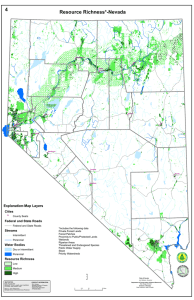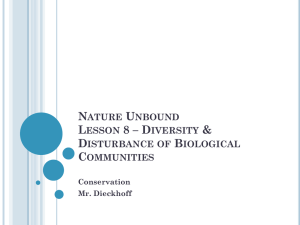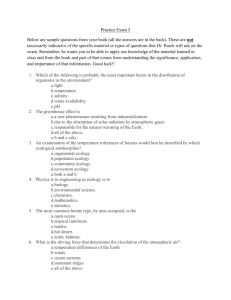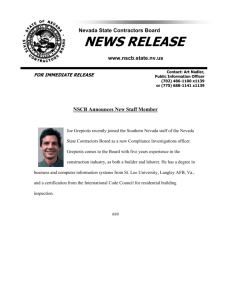Biodiversity Analysis of Vegetation on the Nevada Test Site W. K. Ostler
advertisement
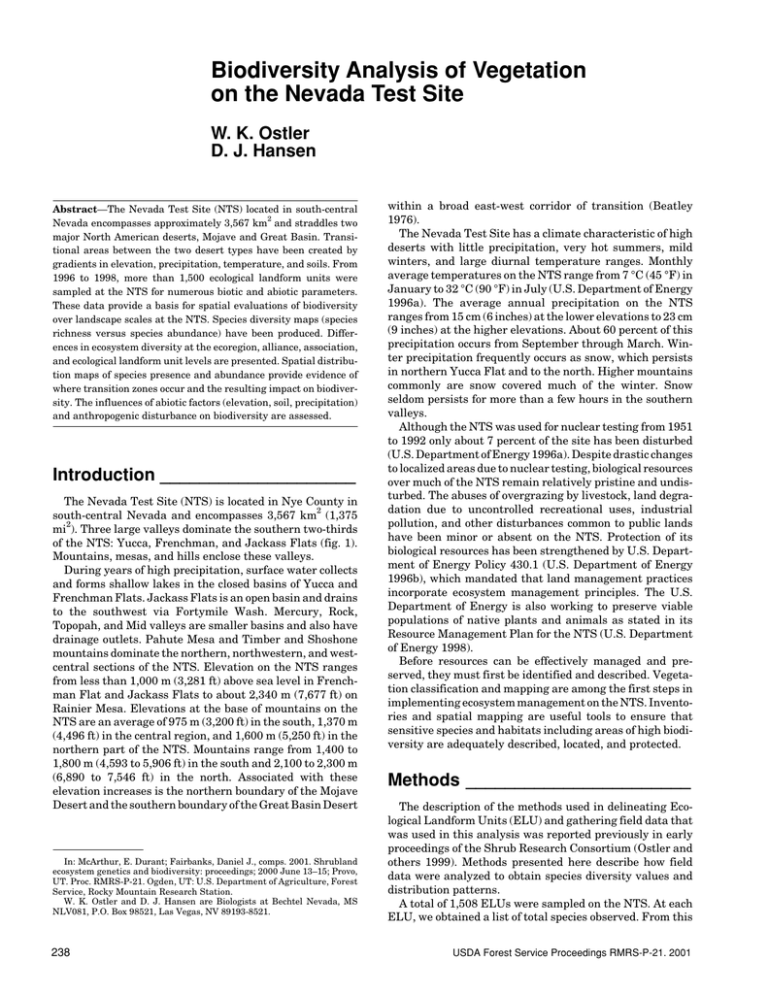
Biodiversity Analysis of Vegetation on the Nevada Test Site W. K. Ostler D. J. Hansen Abstract—The Nevada Test Site (NTS) located in south-central Nevada encompasses approximately 3,567 km2 and straddles two major North American deserts, Mojave and Great Basin. Transitional areas between the two desert types have been created by gradients in elevation, precipitation, temperature, and soils. From 1996 to 1998, more than 1,500 ecological landform units were sampled at the NTS for numerous biotic and abiotic parameters. These data provide a basis for spatial evaluations of biodiversity over landscape scales at the NTS. Species diversity maps (species richness versus species abundance) have been produced. Differences in ecosystem diversity at the ecoregion, alliance, association, and ecological landform unit levels are presented. Spatial distribution maps of species presence and abundance provide evidence of where transition zones occur and the resulting impact on biodiversity. The influences of abiotic factors (elevation, soil, precipitation) and anthropogenic disturbance on biodiversity are assessed. Introduction ____________________ The Nevada Test Site (NTS) is located in Nye County in south-central Nevada and encompasses 3,567 km2 (1,375 2 mi ). Three large valleys dominate the southern two-thirds of the NTS: Yucca, Frenchman, and Jackass Flats (fig. 1). Mountains, mesas, and hills enclose these valleys. During years of high precipitation, surface water collects and forms shallow lakes in the closed basins of Yucca and Frenchman Flats. Jackass Flats is an open basin and drains to the southwest via Fortymile Wash. Mercury, Rock, Topopah, and Mid valleys are smaller basins and also have drainage outlets. Pahute Mesa and Timber and Shoshone mountains dominate the northern, northwestern, and westcentral sections of the NTS. Elevation on the NTS ranges from less than 1,000 m (3,281 ft) above sea level in Frenchman Flat and Jackass Flats to about 2,340 m (7,677 ft) on Rainier Mesa. Elevations at the base of mountains on the NTS are an average of 975 m (3,200 ft) in the south, 1,370 m (4,496 ft) in the central region, and 1,600 m (5,250 ft) in the northern part of the NTS. Mountains range from 1,400 to 1,800 m (4,593 to 5,906 ft) in the south and 2,100 to 2,300 m (6,890 to 7,546 ft) in the north. Associated with these elevation increases is the northern boundary of the Mojave Desert and the southern boundary of the Great Basin Desert In: McArthur, E. Durant; Fairbanks, Daniel J., comps. 2001. Shrubland ecosystem genetics and biodiversity: proceedings; 2000 June 13–15; Provo, UT. Proc. RMRS-P-21. Ogden, UT: U.S. Department of Agriculture, Forest Service, Rocky Mountain Research Station. W. K. Ostler and D. J. Hansen are Biologists at Bechtel Nevada, MS NLV081, P.O. Box 98521, Las Vegas, NV 89193-8521. 238 within a broad east-west corridor of transition (Beatley 1976). The Nevada Test Site has a climate characteristic of high deserts with little precipitation, very hot summers, mild winters, and large diurnal temperature ranges. Monthly average temperatures on the NTS range from 7 °C (45 °F) in January to 32 °C (90 °F) in July (U.S. Department of Energy 1996a). The average annual precipitation on the NTS ranges from 15 cm (6 inches) at the lower elevations to 23 cm (9 inches) at the higher elevations. About 60 percent of this precipitation occurs from September through March. Winter precipitation frequently occurs as snow, which persists in northern Yucca Flat and to the north. Higher mountains commonly are snow covered much of the winter. Snow seldom persists for more than a few hours in the southern valleys. Although the NTS was used for nuclear testing from 1951 to 1992 only about 7 percent of the site has been disturbed (U.S. Department of Energy 1996a). Despite drastic changes to localized areas due to nuclear testing, biological resources over much of the NTS remain relatively pristine and undisturbed. The abuses of overgrazing by livestock, land degradation due to uncontrolled recreational uses, industrial pollution, and other disturbances common to public lands have been minor or absent on the NTS. Protection of its biological resources has been strengthened by U.S. Department of Energy Policy 430.1 (U.S. Department of Energy 1996b), which mandated that land management practices incorporate ecosystem management principles. The U.S. Department of Energy is also working to preserve viable populations of native plants and animals as stated in its Resource Management Plan for the NTS (U.S. Department of Energy 1998). Before resources can be effectively managed and preserved, they must first be identified and described. Vegetation classification and mapping are among the first steps in implementing ecosystem management on the NTS. Inventories and spatial mapping are useful tools to ensure that sensitive species and habitats including areas of high biodiversity are adequately described, located, and protected. Methods _______________________ The description of the methods used in delineating Ecological Landform Units (ELU) and gathering field data that was used in this analysis was reported previously in early proceedings of the Shrub Research Consortium (Ostler and others 1999). Methods presented here describe how field data were analyzed to obtain species diversity values and distribution patterns. A total of 1,508 ELUs were sampled on the NTS. At each ELU, we obtained a list of total species observed. From this USDA Forest Service Proceedings RMRS-P-21. 2001 Biodiversity Analysis of Vegetation on the Nevada Test Site Ostler and Hansen Figure 1—Major topographic features of the Nevada Test Site. USDA Forest Service Proceedings RMRS-P-21. 2001 239 Ostler and Hansen we calculated a species richness value for each ELU. We gathered relative abundance of woody species at each ELU along a 200-m transect. From that abundance data, we calculated species abundance using the Berger-Parker indices for each ELU (Berger and Parker 1970). Based on our vegetation classification, 10 vegetation alliances and 20 associations were recognized as occurring on the NTS (Ostler and others 2000). Alliance and associations are described based on the standardized national classification system described by Grossman and others (1998). Species richness and species abundance were calculated for each association and alliance. Species richness was determined by recording all unique species in each ELU. Species richness for associations, alliances, and ecoregions were obtained by averaging of the species richness values for every ELU within that association, alliance, or ecoregion. Species abundance was obtained by averaging the species abundance values obtained for every ELU within that association, alliance, or ecoregion. Two major ecoregions, Mojave Desert and Great Basin Desert, can be identified from the vegetation classification of the NTS. Between these two deserts is a broad transition zone that often includes a mixture of species from either major ecoregion. Beatley (1976) refers to this climatic zone as the “Transition Desert” and recognized several plant associations within this zone. We evaluated ecosystem diversity within these three major areas. Comparisons of species richness and species abundance were made for each ecoregion. There are three alliances within the Mojave Desert, three within the transition zone, and four within the Great Basin Desert. In terms of total area, the Great Basin Desert occupies approximately 40 percent of the NTS, followed by the transition zone with 37 percent. The Mojave Desert occupies the southern 22 percent of the NTS. Sampling within each major zone was rather even with the average areas per ELU being 216 ha in the Mojave Desert, 221 ha in the Transition Zone, and 233 ha in the Great Basin Desert. Results ________________________ Biodiversity Analysis of Vegetation on the Nevada Test Site represents 67 percent of the total number of species (~694) that are listed as occurring on the NTS. Most of the species observed were forbs or grasses (~74 percent ) while shrubs represented about 24 percent . The species richness for all of the perennial species is shown in figure 3. The pattern of distribution for perennial species is similar to that for all species. Species Abundance—The values obtained for species abundance for the 1,508 ELUs using the Berger-Parker index ranged from a low of 1 to a high of 6.25 (fig. 4). Four ELUs had values of 6.25 while 11 ELUs had the second highest values, 5.56. On the other end of the scale, 11 ELUs had values of 1.00, meaning that a single species dominated these sites. However, it was not always the same species that was dominant. In those 11 ELUs with values of 1.00, seven different species dominated at least one of the ELUs. White burrobush (Hymenoclea salsola) dominated 3 ELUs while fourwing saltbush (Atriplex canescens) and black sagebrush (Artemisia nova) dominated in 2 ELUs. Basin big sagebrush (Artemisia tridentata), shadscale (Atriplex confertifolia), rubber rabbitbrush (Ericameria nauseosa), and blackbrush (Coleogyne ramosissima) dominated in 1 ELU each. Most of the ELUs (75 percent) had species abundance values under 3 while approximately 42 percent of the ELUs had species abundance values less than 2 (fig. 4). Analysis at Plant Association Level Species Richness—Of the 20 plant associations recognized on the NTS, species richness ranged from a low of 13.0 in the Atriplex confertifolia-Kochia americana shrubland to a high of 38.6 in the Artemisia nova-Artemisia tridentata shrubland (table 1). The range of richness values among ELUs within each association was very high. Those sites that had poor or harsh soils or that had been subject to previous disturbance such as in Yucca Flats tended to have low species richness. There also appears to be a positive relationship of species richness at the association level with elevation and precipitation. Species diversity has been measured by numerous methods with each method having advantages and disadvantages. The management objective of the land manager often determines which measure of diversity should be used. Two major types of indices, species richness and species abundance (evenness), are generally recognized in ecological literature and these are discussed by Magurran (1988). In this paper, we report measures for both types of indices using two of the more commonly accepted techniques. Results of our analyses are reported at four different levels of scale, ELU, association, alliance, and ecoregion. Species Abundance—The Berger-Parker values for associations ranged from a low of 1.62 in the Artemisia novaChrysothamnus viscidiflorus shrubland to a high of 4.03 in the Menodora spinescens-Ephedra nevadensis shrubland. Values for all associations are reported in table 1. The species abundance of associations does show that transition associations tend to have higher species abundance than Mojave or Great Basin associations with the exception of the Coleogyne ramosissima-Ephedra nevadensis shrubland. Statistical analysis showed that there is no significant correlation between species richness and species abundance 2 on an association level (r = 0.15). Analysis at Ecological Landform Unit Level Analysis at Plant Alliance Level Species Richness—Species richness (or the number of species) of all species encountered within each ELU is shown in figure 2. Species richness varied tremendously across all ELUs ranging from a low of 1 to a high of 69. The mean species richness was 24.3 ± 10.9. The total number of species observed across all ELUs during this study was 466. This Species Richness—Species richness values ranged from a low of 15.8 in the Atriplex spp. shrubland to a high of 33.7 in the Pinus monophylla/Artemisia spp. woodland alliance. Species richness values for all associations are reported in table 2. Those alliances that have less favorable soil conditions (Lycium shockleyi-Lycium pallidum shrubland alliance, Atriplex spp. shrubland alliance) or that have been 240 USDA Forest Service Proceedings RMRS-P-21. 2001 Biodiversity Analysis of Vegetation on the Nevada Test Site Ostler and Hansen Figure 2—Species richness of all species for ELUs on the Nevada Test Site. USDA Forest Service Proceedings RMRS-P-21. 2001 241 Ostler and Hansen Biodiversity Analysis of Vegetation on the Nevada Test Site Figure 3—Species richness of perennial species for ELUs on the Nevada Test Site. 242 USDA Forest Service Proceedings RMRS-P-21. 2001 Biodiversity Analysis of Vegetation on the Nevada Test Site Ostler and Hansen Figure 4—Species abundance using the Berger-Parker index for ELUs on the Nevada Test Site. USDA Forest Service Proceedings RMRS-P-21. 2001 243 Ostler and Hansen Biodiversity Analysis of Vegetation on the Nevada Test Site Table 1—Species diversity for plant associations. Shrubland associations Lycium shockleyi-Lycium pallidum Larrea tridentata/Ambrosia dumosa Atriplex confertifolia-Ambrosia dumosa Lycium andersonii-Hymenoclea salsola Hymenoclea salsola-Ephedra nevadensis Menodora spinescens-Ephedra nevadensis Krascheninnikovia lanata-Ephedra nevadensis Eriogonum fasciculatum-Ephedra nevadensis Ephedra nevadensis-Grayia spinosa Coleogyne ramosissima-Ephedra nevadensis Atriplex confertifolia-Kochia americana Atriplex canescens-Krascheninnikovia lanata Chrysothamnus viscidiflorus-Ephedra nevadensis Ericameria nauseosa-Ephedra nevadensis Ephedra viridis-Artemisia tridentata Artemisia tridentata-Chrysothamnus viscidiflorus Artemisia nova-Chrysothamnus viscidiflorus Artemisia nova-Artemisia tridentata Pinus monophylla/Artemisia novaa Pinus monophylla/Artemisia tridentataa a No. of ELUs Species richness Species abundance 6 283 49 13 44 45 30 14 89 323 19 38 76 21 20 139 103 30 78 58 19.0 18.2 19.1 23.2 21.9 17.5 19.3 22.5 25.5 21.2 13.9 16.7 28.4 22.7 36.0 29.9 32.3 38.6 34.3 33.3 1.99 2.39 3.21 4.03 3.45 2.22 2.25 3.30 3.56 2.03 1.80 1.91 2.84 2.23 3.24 1.82 1.62 2.85 2.84 1.95 Woodland associations. Table 2—Species diversity at the alliance level. Alliances Lycium shockleyi-Lycium pallidum shrubland Larrea tridentata/Ambrosia dumosa shrubland Atriplex confertifolia-Ambrosia dumosa shrubland Hymenoclea-Lycium shrubland Ephedra nevadensis shrubland Coleogyne ramosissima shrubland Atriplex spp. shrubland Chrysothamnus-Ericameria shrubland Artemisia spp. shrubland Pinus monophylla/Artemisia spp. woodland disturbed routinely (Hymenoclea-Lycium shrubland alliance) tend to have both lower species richness and species abundance. Species Abundance—The Berger-Parker values for alliances ranged from a low of 1.87 in the Atriplex spp. shrubland alliance to a high of 3.37 in the Ephedra nevadensis shrubland alliance. The Ephedra nevadensis shrubland alliance contains the top four associations in terms of species abundance. Values for all alliances are reported in table 2. Analysis at Ecoregion Level Species Richness—Species richness was greatest in the Great Basin Desert ecoregion. This ecoregion had a mean of 30.1 species compared to associations in the Transition Zone (mean of 21.9 species) and the Mojave Desert (mean of 18.9 species). Similar species diversity patterns were also observed for all combined perennial species on the NTS (for example, Great Basin Desert: 22.8 species per ELU, Transition Zone: 244 Species richness 19.0 18.2 19.1 17.5 23.2 21.2 15.8 27.2 32.1 33.7 Species abundance 1.99 2.39 3.21 2.22 3.37 2.03 1.87 2.71 1.95 2.33 17.5 species per ELU, and Mojave Desert: 13.6 species per ELU). Species Abundance—the Berger-Parker index showed that unlike species richness the Mojave Desert ecoregion had the highest species abundance with an average value of 2.67. This was followed by the Transition Zone with a value of 2.45 and the Great Basin Desert with a value of 2.15. Analysis of Individual Species An advantage of having data in a GIS format is that it allows us the flexibility to spatially display any or all of the data. We can display the distribution of a single species on the NTS. Not only is the presence of the species noted in each ELU, but we can display the relative abundance of the species in each ELU of occurrence (fig. 5). This also allows spatial analysis of congeneric species and other associated species and can help identify those environmental parameters that separate the distribution of those species. For example, figure 6 shows the distribution of the three species USDA Forest Service Proceedings RMRS-P-21. 2001 Biodiversity Analysis of Vegetation on the Nevada Test Site Ostler and Hansen Figure 5—The distribution and relative abundance of blackbrush on the Nevada Test Site. USDA Forest Service Proceedings RMRS-P-21. 2001 245 Ostler and Hansen Biodiversity Analysis of Vegetation on the Nevada Test Site Figure 6—The distribution of three species of yuccas on the Nevada Test Site. 246 USDA Forest Service Proceedings RMRS-P-21. 2001 Biodiversity Analysis of Vegetation on the Nevada Test Site Ostler and Hansen of yucca on the NTS. Mojave yucca (Yucca schidigera) is a Mojave Desert species and only occurs in the lower and hotter portions of the NTS. Joshua tree (Yucca brevifolia) is a transitional species and occurs in the central portions of the NTS while banana yucca (Yucca bacata) prefers the higher elevations and areas of greater precipitation that are characteristic of the Great Basin portions of the NTS. Modality of Woody Species A total of 117 woody species were encountered on the transects from which relative abundance values were obtained. Each of these species was evaluated for modality, in other words, the association that each species reached its maximum relative abundance. Three associations, Pinus monophylla/Artemisia tridentata woodland (16), Menodora spinescens-Ephedra nevadensis shrubland (12) and Atriplex confertifolia-Ambrosia dumosa shrubland (11), had a large number of modal species (table 3). Other associations, Lycium andersonii-Hymenoclea salsola shrubland, Lycium shockleyiLycium pallidum shrubland, and Artemisia tridentataChrysothamnus viscidiflorus shrubland had very few, 1, 2, and 2, respectively. Four other associations had only three modal species. The average number of modal species appeared to be independent of the number of species that occurred within an association (compare species richness in table 1 and table 3). Table 3—Woody species modality in each vegetation association. Shrubland associations No. of modal species Lycium shockleyi-Lycium pallidum Larrea tridentata/Ambrosia dumosa Atriplex confertifolia-Ambrosia dumosa Lycium andersonii-Hymenoclea salsola Hymenoclea salsola-Ephedra nevadensis Menodora spinescens-Ephedra nevadensis Krascheninnikovia lanata-Ephedra nevadensis Eriogonum fasciculatum-Ephedra nevadensis Ephedra nevadensis-Grayia spinosa Coleogyne ramosissima-Ephedra nevadensis Atriplex confertifolia-Kochia americana Atriplex canescens-Krascheninnikovia lanata Chrysothamnus viscidiflorus-Ephedra nevadensis Ericameria nauseosa-Ephedra nevadensis Ephedra viridis-Artemisia tridentata Artemisia tridentata-Chrysothamnus viscidiflorus Artemisia nova-Chrysothamnus viscidiflorus Artemisia nova-Artemisia tridentata Pinus monophylla/Artemisia novaa Pinus monophylla/Artemisia tridentataa a 2 3 11 1 7 12 4 3 4 8 3 3 6 6 7 2 6 5 8 16 Conclusions ____________________ Understanding what is meant by diversity of an area can be very difficult because there are many measures of diversity over different spatial and temporal scales. The two common measures of diversity, species richness and species abundance, are not necessarily correlated as shown in this study. When we compared diversity at an ecoregional scale, richness and abundance appear to be inversely related. Low species richness appears to be associated with poor soil conditions and disturbances. Species richness appears to be related to increased elevation and precipitation at the NTS with those associations and alliances in the Great Basin Desert having higher values. Species abundance does not show this pattern. Species abundance is often greater in transition associations (four of the top five are transitional associations) and alliances. There are large differences in species modality in vegetation associations; however, no regional patterns are discernable as to their distribution. References _____________________ Beatley, J. C. 1976. Vascular plants of the Nevada Test Site and central-southern Nevada: ecologic and geographic distributions. TID-26881. Energy Research and Development Administration, Division of Biomedical and Environmental Research. 308 p. Berger, W. H.; Parker, F. L. 1970. Diversity of planktonic Foraminifera in deep sea sediments. Science. 168: 1345–7. Grossman, D. H.; Faber-Langendoen, D.; Weakley, A. S.; Anderson, M.; Bourgeron, P. S.; Crawford, R.; Goodin, K.; Landaal, S.; Metzler, K.; Patterson, K.; Pyne, M.; Reid, M.; Sneddon, L. 1998. International classification of ecological communities: terrestrial vegetation of the United States. Volume I. The national vegetation classification system: development, status and applications. Arlington, VA: The Nature Conservancy. Magurran, A. E. 1988. Ecological diversity and its measurement. Princeton, NJ: Princeton University Press. 178 p. Ostler, W. K.; Hansen, D. J.; Hall, D. B. 1999. The classification of shrublands on the Nevada Test Site. In: McArthur, E. D.; Ostler, W. K.; Wambolt, C. L., comps. Proceedings: shrubland ecotones; August 12–14 1998; Ephraim, UT. Proceedings RMRS-P-11. Ogden, UT: U.S. Department of Agriculture, Forest Service, Rocky Mountain Research Station: 137–147. Ostler, W. K.; Hansen, D. J.; Anderson, D. C.; Hall, D. B. 2000. Classification of vegetation on the Nevada Test Site. DOE/NV/ 1171-477. Las Vegas, NV: U.S. Department of Energy, Nevada Operations Office. U.S. Department of Energy. 1996a. Final environmental impact statement for the Nevada Test Site and off-site locations in the state of Nevada, Volume 1. DOE/EIS 0243. Las Vegas, NV: U.S. Department of Energy, Nevada Operations Office: Chapters 1–9. U.S. Department of Energy. 1996b. DOE Policy 430.1, Land and Facility Use Planning. Washington, DC. U.S. Department of Energy. 1998. Nevada Test Site Resource Management Plan. DOE/NV-518. Las Vegas, NV: Nevada Operations Office. Woodland associations. USDA Forest Service Proceedings RMRS-P-21. 2001 247
